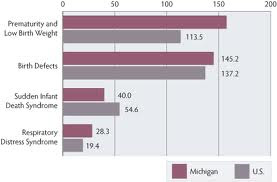 For the first time ever, the federal census of 2010 will produce demographic data for each school district in Michigan. In the past, census figures were available with detail data for all counties, cities and townships, but not for school districts. When the data is fully released for the first time the census will present details on population, poverty, income, etc. for each school district in the state.
For the first time ever, the federal census of 2010 will produce demographic data for each school district in Michigan. In the past, census figures were available with detail data for all counties, cities and townships, but not for school districts. When the data is fully released for the first time the census will present details on population, poverty, income, etc. for each school district in the state.Poverty in Michigan has increased in the past decade. Dramatically. In 2009, the U.S. Census estimated that one in five school-age children in Michigan were poor. That's more than 340,000 school age children living in poverty. The final release of the 2010 census will or will not confirm this number. Still, if the census estimates were even close to being right, and if one child living in poverty is a shame, 340,000 Michigan children living in poverty is tragic.
The federal poverty guidelines defines a family of four as being poor if their annual income is $22,050 or less. That isn't a lot of dough to pay the rent or mortgage, buy groceries, put gas in the car in order to get to work or grocery store, let alone buy school clothes and school supplies for the children.
In the past, the best gauge of the number of poor children in a school district was the district's total free and reduced lunch count participation. This data has been available for more than a decade and is published annually by the Michigan Center for Educational Performance and Information in Lansing. The federal free school lunch guidelines are only slightly higher than the poverty guidelines. A child from a family of four qualifies for free school lunch (and breakfast in most districts) if the child's family makes $28,665 or less per year.
While it is true that in the United States our poverty is not the same kind of poverty one finds in third world countries, it is also true that a family living on less than $28,665 per year probably isn't living the life of Bill (Gates, Cosby or Clinton).
www.heraldpalladium.com/articles/2011/11/30/opinion/editorials/7508108.txt
Note: source of the above graph:
http://www.project.org/info.php?recordID=467
















